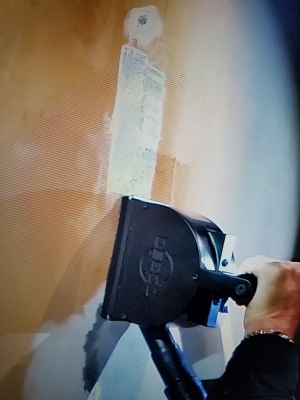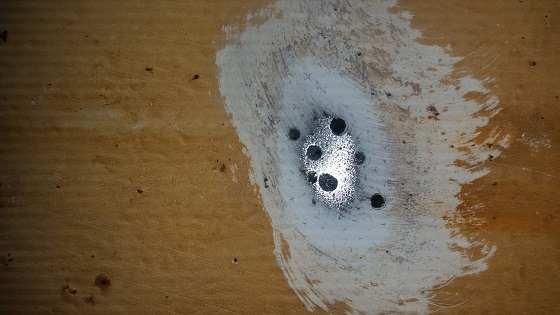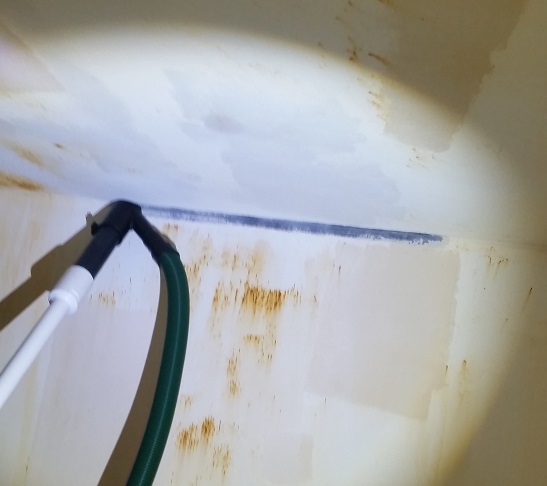A novel corrosion control prevention kit from Desco Manufacturing, Inc. (Rancho Santa Margarita, California, USA) utilizing shrouded surface preparation tools and demonstration videos aims to improve the efficiency of in-house maintenance crews for maritime assets such as cruise ships and tankers.
Chris Patenaude, director of maritime and industrial sales at the company and a NACE International-certified Coating Inspector Program (CIP) Level 3 Inspector, witnessed many common pitfalls firsthand in his prior role as global fleet superintendent for coatings and linings at a well-known cruise line.
 “I was evaluating tools from all kinds of manufacturers to find a solution to doing surface prep while at sea,” said Patenaude, whose résumé
boasts 30 years of related industry experience and certifications. “Whether it’s a tanker or a cruise ship, stopping for maintenance is difficult for the industry as a whole. If it’s not running, they’re not making money. They don’t stop.”
“I was evaluating tools from all kinds of manufacturers to find a solution to doing surface prep while at sea,” said Patenaude, whose résumé
boasts 30 years of related industry experience and certifications. “Whether it’s a tanker or a cruise ship, stopping for maintenance is difficult for the industry as a whole. If it’s not running, they’re not making money. They don’t stop.”
In general, time constraints and a desire to avoid inconveniencing guests with excessive noise have often led to inadequate surface preparation practices for maritime assets.
“As coatings or linings have firmly specified curing times and application conditions, often surface preparation becomes the compromise,” Patenaude said. “Due to the fact that most coating failures are due to inadequate surface preparation, this becomes a repetitive expense of labor, materials, and precious maintenance time when the spot has to be repaired again just a few weeks or months later.”
For his in-house crews, Patenaude said not understanding issues related to corrosion was a routine problem. “If you’re on a ship, it’s because you have a skill that relates to the ship,” he said. “It doesn’t usually involve coatings and linings. They have limited knowledge because it’s not their specialty.”
Based on the lack of understanding of why a surface profile is necessary or what cleanliness is required, as per industry standards, Patenaude said this leads to attention not being given to the most essential part of coating repairs: the surface preparation.
“Traditionally, they’ll go out with a chipping hammer and a wire brush and slap a coat of paint on it,” Patenaude said. “But it’s a marine surface in a salt water environment. That’s not enough. The challenge is getting someone whose specialty is running a ship to understand that there’s a corrosion issue there, and if you fix that corrosion issue, you won’t have to paint that spot again.”
While the selection of chipping hammers and wire brushes may help to mitigate noise, it often does not fix the underlying corrosion problem.
“The rework I encountered in the cruise industry was tremendous, especially in tanks,” Patenaude added. “Every time they opened a tank, if they fixed a pit or corrosion cell, they’d do minimal repair and then open it up for the next inspection, and many times it would fail again. Eventually this would lead to a corrosion pit with depth, and steel loss. On a single-hull ship, that’s a big problem.”
One feature the operator particularly appreciated about the Desco kit was the inclusion of demonstration videos — including training videos for non-English speakers — on top of the complement of tools. “We often have international crews with a wide range of nationalities, but using the videos showed them physically how to use the tools,” Patenaude said. “There’s a non-verbal component to it.”
As for the shrouded tools, the kit includes a pneumatic mini-flush plate scarifier with a 3M Roto Peen hub; an electric FX tool with a cutter hub; a pneumatic mini-die grinder; and a pneumatic Model 40 needle gun with both standard and extended reach.
“It’s a safer system,” Patenaude said. “Since these are shrouded tools, I’m not filling the air with hazardous dust or dropping chips over the side and contaminating whatever nice tropical port I’m in.”
The operator recently chose to test the kit on a potable steel water tank that was on a 14-day dry dock in the Bahamas. The amine-cured epoxy coating on this tank was originally applied at 16 to 20 mils (406 to 508 microns), but the operator knew the tank had corrosion cells forming beneath the coating’s surface. These cells were starting to erupt, leading to streak and pinpoint rusting.
Utilizing test areas ranging from 1 to 5 square feet (0.09–0.46 m2), a six-person crew of Romanian maintenance workers watched the videos and quickly got to work.
“We were testing it not to replace the entire coating of the tank,” Patenaude explained. “We were looking for a system to do touchups all over the ship for when they do their periodic maintenance at sea. I knew my people wouldn’t always know about coatings, but I knew if I could find the right tool and put it in their hands, I could bypass that lack of knowledge.”
One early benefit they found with the system was a reduction in personal protective equipment (PPE) needs. “All they needed were safety glasses and ear plugs, because it’s shrouded and hooked to a HEPA [high-efficiency particulate air] vacuum,” Patenaude said. By not using high-pressure waterjetting equipment, this allowed crew members to avoid the heat stress hazards often associated with full-body suits in humid, tropical environments.
The flush plate removed 90 percent of the coating in one pass, with the remaining 10 percent removed on the second pass. An Elcometer 6000 surface profile meter was used to verify surface profile readings, which averaged 1.8 to 2.3 mils (45.7–58.4 microns). Meanwhile, a visual inspection showed the crew had achieved the desired Society for Protective Coatings (SSPC) Surface Preparation (SP) 11: Power Tool Cleaning to Bare Metal. These results reflected the appropriate surface as recommended by the coating manufacturer’s technical data sheet.
“The flush plate has flaps,” Patenaude explained. “It has a wheel with stars on it. As it rotates, it comes down and impacts the surface, removing what was there and providing a profile. Instead of spinning horizontally like a grinder, it rotates like a drum.”

For heavier coatings, Patenaude said the cutter hub could be used in lieu of the flush plate. “The cutter hub is mainly for stripping very heavy coatings,” he said. “It’s more of a scarifier. If I had 150 mils [3,810 microns] on the deck, I’d want to use a cutter hub. But in a tank with 20 mils [508 microns] of coating on it, I’d use the flush plate with the roto peen.”
Meanwhile, the mini-die grinder was used to open up corrosion cells beneath the prior coating. In their testing operation on the tank, numerous pits of 2 to 3 mm (0.08–0.12 inches) depth were exposed.
“The die grinder was able to reach the bottoms of the pits while simultaneously feathering the edge of the repair,” Patenaude said. “This is a good painting practice for repairs to prevent undercutting of the repaired area and give the repair greater adhesion to the surface.” Because of its “quiet motor,” he said the grinder has also proved popular in performing topside surface preparation work.
Finally, the extended reach needle gun was used to strip the upper weld and areas along the ceiling. Surface profile was not conducted on this area due to lack of access, but a visual inspection showed the desired SSPC-SP-11 white metal surface.
“When you’re in a tank on a ship, there’s usually not a ladder or scaffolding,” Patenaude said. “So the needle gun is really useful for reaching welds and the undersides of balconies. Instead of crew members being tied off with a harness and standing on a railing while chipping away at the coating, they can reach out with that thing safely and hit rust spots.”
With shroud attachments, the system greatly reduced the cleanup time after surface preparation, which Patenaude said often required a full 8-hour shift with traditional methods. “The process allows for quicker repairs to be performed, less worker exposure to injury from dust inhalation or grinding disks fracture, and a greatly reduced cleanup, decontamination, and return to service,” he noted.
In the end, Patenaude said feedback was “very positive,” adding that the operator bought multiple kits for its crews and has used them successfully ever since. Perhaps most noteworthy, Desco was so impressed by Patenaude’s knowledge of the system and its potential benefits for asset owners that they hired him themselves to promote the system to the maritime industry.
“I’ve been to [industry] shows this year and had lots of tug operators inquire about it,” Patenaude said. “They want to be able to do prep, but they don’t want to wake up anyone who is off shift. They can also use these tools on the decks with guests on board, whereas normally a guest would complain about noise. It’s exactly what I was looking for and trying to get.”
Reprinted with permission from Maritime News (Summer 2018, www.nace.org/resources/newsletters/maritime-news).
